From Waitukubuli to Zanzibar: Join the Green Travel Explorers’ Club
The Green Travel Guide: Mindful Travel for a Meaningful World
If you’re new here, I share three weekly newsletters through the lens of a novelist and travel writer: Storycraft on Sundays on the art of creativity & story, Write Your Way Around the World on Tuesdays on travel writing and building a writing career you love, and The Green Travel Guide on Thursdays.
This week in The Green Travel Guide, we’re trekking the Waitukubuli Trail in Dominica and travelling to Zanzibar to explore Freddie Mercury’s Stone Town. If you’re in search of travel adventure inspiration for the year ahead, get your free copy of 7 Green Adventures To Do This Year, and details on how to join the Explorers’ Club.
Travelling to Waitukubuli (Dominica) to trek the longest hiking trail in the Caribbean
Waitukubuli (meaning ‘tall is her body’) was the name originally given by the Kalinago people to Dominica. It perfectly captures the island’s soaring mountains, deep valleys, and cloud-swept ridges. To hike the Waitukubuli National Trail is to follow the spine of this “tall” island: 115 miles stretching from its southern beaches to the northern coastline. It’s the longest hiking trail in the Caribbean, climbing from black-sand beaches into cloud forest ridges where the air turns moss-thick and cool.
Each step carries you through rainforest and river, past waterfalls, volcanic peaks, and villages where life moves slowly. Breadfruit trees shade wooden houses, past steaming fumaroles and rivers still reshaped by Hurricane Maria’s force back in 2017, when much of the island was decimated by the force of the hurricane.
Walking the trail is more than a hike—it’s a journey through Dominica’s history, culture, and fragile ecosystems, a chance to witness both its beauty and the challenges it faces in a changing world.
The trail runs, island-length, through the heart of the island. Trek to the lyrically named Valley of Desolation formed of volcanic craters, and an extraordinary geothermal site, in search of the ‘Boiling Lake’ (the world’s second-largest hot lake) to watch the water bubble surrounded by wispy tendrils of vapour in the Morne Trois Pitons National Park. Or, if you prefer you can kayak on the Waitukubuli Sea Trail, set up in 2023 by Soufrière Outdoor Centre - a sea-kayaking route running from south to north of the island coastline over 6 days (though you can tackle one or two segments for a shorter experience).
Either way, this is travel that takes time, travel that spends time and money in the small guesthouses and homestays scattered along the trail. On the hiking trail, each segment of the path is linked to local guides who share not just directions but stories of plants, folklore, and resilience. Trekking here supports communities directly, giving reason to protect forests and traditional livelihoods rather than clearing them.
The trail has become a symbol of Dominica’s ambition to be the world’s first “climate-resilient” nation, a vision born from necessity as much as hope.
But the challenges aren’t hidden. Dominica is still recovering from the devastation of Hurricane Maria, which destroyed homes, uprooted crops, and tore apart sections of the trail itself. Climate vulnerability shadows every conversation. Many young people leave the island in search of work, heading to neighbouring islands like Martinique or Guadeloupe, or further afield. Communities along the trail sometimes struggle to see consistent income from hikers. Maintenance of the path requires funding that isn’t always steady. Tourism brings with it opportunity, but also pressure: and the challenge of balancing ecological protection with economic need.
Walking the Waitukubuli Trail, you’re reminded that green travel here isn’t just about admiring untouched landscapes — it’s about being part of a fragile, ongoing recovery. Choosing local guides, staying in community-run accommodations, and traveling in the off-season can make a difference.
There are struggles. Beyond the brain drain and the issues of maintenance, there is concern among the Kalinago that they are not always fully included in decision-making, especially over climate adaptation, development planning, and that some environmental degradation (erosion, siltation, landslides) is affecting their lands, freshwater, coastal areas. Part of the island is Kalinago Territory.
The hurricane greatly damaged the island’s health infrastructure which has been depleted further with a lack of adequate resourcing. Mental health issues too, unsurprising in the face of such devastation on a wide scale (the storms destroyed many of the island homes and livelihoods) combined with oftentimes poverty and rural living, are struggles that some islanders face day-to-day.
Yet Dominica is actively seeking to become one of the first climate-resilient nations. Forest regeneration, biodiversity protection, sustainable forest policy, more protected areas and ecotourism are part of that vision.
As part of recovery, the government has built “climate-resilient” homes, especially in vulnerable areas (including Kalinago Territory). Features include sturdier roofs and concrete structures.
Still, many homes remain vulnerable, and there is pressure to ensure that rebuilding honours local styles, culture, and is accessible.
Despite the challenges, mindful travellers prepared to contribute to the local economy and connect to the island cultures will find it a rewarding place to visit with remarkable landscapes and a rich history to discover.
Tips: Hire local guides for the trail hiking - both for safety (note sections 7-9 of the trail involve scrambling over/around obstacles from storm damage) and to learn more about the island’s history and culture. Contact Wes Moses at Soufrière Outdoor Centre for the sea-kayaking route. Weather-wise hurricane season runs June - November.
Freddie Mercury’s Stone Town - A Zanzibar Childhood & Green Island Travels
Music legend Freddie Mercury was born here, in Stone Town in Zanzibar — long before the narrow coral-stone alleys and wooden balconies became a UNESCO site, long before cruise ships began anchoring just offshore. His old house, now painted in pale pastels, is easy to walk past unless you’re looking for it. And yet, it serves as a reminder: Zanzibar has always been more than its postcard beaches, always layered with culture, story, and song.
Born Farrokh Bulsara in the island’s hospital, to a Zoroastrian family with Persian and Indian roots, Freddie spent his early years on the island. In Stone Town’s narrow streets full of shops and spice bazaars, that family home by the sea, can be visited today.
It’s hard to imagine when looking at the idyllic palm-trees and blue sky backdrop, but in 1964 a violent uprising saw thousands of people killed on the island, and many families fleeing, including his own.
These days, the islands are peaceful and welcoming. Tourism is big business - and Zanzibar proudly shares its African, Arab, European and Indian influences - a reflection of its history as a trading post for Arab, Persian and African spice and ivory traders. It was also at the heart of the East African slave trade until abolition in 1897. Ruled by the Portuguese for almost 200 years, then the Omani’s, and the British before independence, here you’ll hear Swahili, Arabic and English spoken. The cultural mix is reflected in the eclectic food you’ll find on offer. You’ll also often hear Italian - the island is popular with Italian tourists, and Italian companies have invested heavily in the tourism landscape.
Learn a few words of Swahili and you’ll be warmly greeted back.
To travel green in Zanzibar is to look beyond the postcard-pretty surface. Yes, there are the swaying palms of Nungwi and Kendwa (along with easy travel all-inclusive resorts) and the seductive turquoise shimmer of the Indian Ocean, but the real heart of the island is quieter: women farming seaweed along the coast, fishermen bringing in the day’s catch, spice farmers inviting you into their groves where cinnamon curls from the bark. Choosing to stay in family-run guesthouses or eco-lodges rather than sprawling resorts keeps your footprint smaller and your connection deeper. Check out Jambiani or Bwejuu for a more authentic island stay.
There are plenty of ways to make a difference. A guided walk in Jozani Forest helps protect the endangered red colobus monkeys. Touring a spice farm sustains local growers and preserves agricultural knowledge. Take a trip to Chumbe Island, a designated marine protected area, and contribute to efforts to restore the local ecosystem. This Coral Reef Sanctuary and Forest Reserve is supported by the money raised through ecotourism. You can stay in one of the island’s zero impact eco-accommodations, and learn about the Swahili Cuisine of Zanzibar. Even something as simple as buying kangas in the market (try Darajani market) rather than imported souvenirs ripples out into the community.
But Zanzibar, in the wake of its embrace of tourism, also faces environmental challenges. Waste disposal struggles against the tide of plastic, coral reefs strain under careless snorkelling and the warming seas, and freshwater scarcity is an unspoken concern behind every cold shower. Some tours still chase dolphins or commodify encounters without considering animal welfare - choose wisely.
And yet, the island offers countless ways to tread more lightly. Swim in Menai Bay’s conservation area making sure to book with an ethical operator who funds marine conservation. Sail by dhow, explore the mangrove forests and swim in the pristine waters of the bay. Spend a morning with a women’s seaweed cooperative and see how climate resilience is built into livelihood. Wander Stone Town not only for its beauty, but to learn more about the layered histories of trade, migration, and struggle.
Green travel here is about slowing down and getting onto island time, listening, connecting and being mindful - it’s in the small choices and actions we make. That way the island can keep singing long after we’re gone.
The Ultimate Green Travel Guide:100 Inspiring Adventures
Work is underway on final edits for the upcoming The Ultimate Green Travel Guide: 100 Inspiring Adventures. This book is packed with eco-adventures on every continent and will take you to places you’ve not yet discovered, and show you new ways to travel more familiar destinations.
It also includes plenty of practical and actionable advice on how to travel in a more sustainable and mindful way.
If you’d like to be an early reader/reviewer drop me a DM (just put BOOK) in the DM and I’ll get in touch.
And if you want to get your copy of the book, you can pre-order here.
To celebrate the upcoming launch of The Ultimate Green Travel Guide: 100 Inspiring Adventures I’m sharing a free mini-guide to 7 Green Adventures To Do This Year - get your copy here for some eco-travel inspiration!
Explorers’ Club
Each month Green Travel Guides publishes new eco-destination guides and slow travel curated itineraries, along with mini-guides like our Canary Islands Green Adventures guide or our Slow City guides.
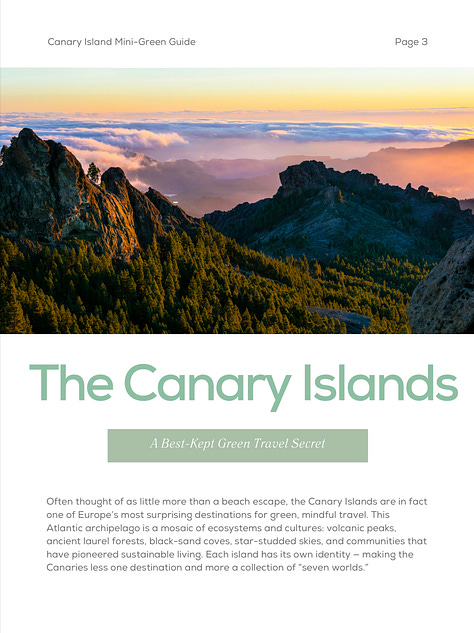
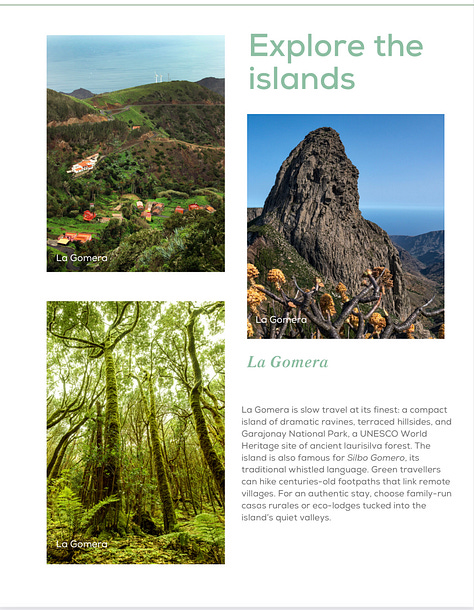
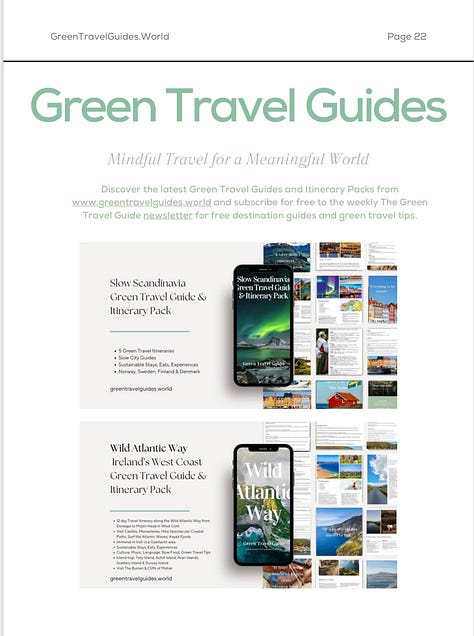
The Explorers’ Club is opening in October. For the next year all paid subscribers (60€ p/year or 6€ a month - basically the cost of a coffee) here on Substack will also receive a free subscription to the Explorers’ Club which includes:
- free access every month to the latest digital Green Travel Guides, Mini-Guides and Slow City Green Guides (worth over $200 p/year)
Paid Subscriber Benefits include:
For Travellers
- 3 weekly newsletters on mindful travel, travel writing and writing
One Year’s Free Subscription to the Explorers’ Club (get sent the latest Green Travel Guides monthly for FREE - value $200+)
Full access to Travel Journal Club including interviews with adventurers, travel writers and photographers + Monthly Club Sessions for travel journaling ++ [Starting in October]
Monthly behind-the-scenes post with additional recommendations, stories and content
Benefits as for writers below
For Writers
- 3 weekly newsletters on writing, travel writing and mindful travel
Travel Writer’s Starter Kit + Pitch Pack for free (value: $83)
Free Audio Masterclasses
Full Travel Journal Club membership including interviews with adventurers, travel writers and photographers + Monthly Club Sessions for travel journaling ++[Starting in October]
50% off Story Audit (send me an excerpt of your work and I’ll provide detailed feedback)
Early Bird Access to 2026 Mediterranean Writers’ Retreat
Readers’ Circle
10% Course Discounts (join any travel-writing.com course and receive your discount code)
Explorers’ Club free subscription & receive all Green Travel Guides for a year for free (value: $200+)
This week - Green Travel & Slow Travel Content I loved:
This excellent post by Andrew Paget about the Amazon (along with soundscape recording) is really immersive and gives such a great insight into not just place, but the challenges faced there.
Laura Jackson’s family trip to the Wild Atlantic Way caught my eye: If you’re interested in the west coast of Ireland, you can download our free Wild Atlantic Way 12 Day Itinerary (packed full with where to stay, eat; where to go & how; what to do, see - all through a slow travel lens).
This peaceful photograph from Sadie at The Slow Living Lane stopped the scroll:
If you’ve enjoyed this green travel content, consider sharing, restacking, commenting, subscribing or recommending. Much appreciated! 🗺️ 🌍 💚
Happy Travels,
Laura
Laura McVeigh
Author, Travel Writer, Founder - Green Travel Guides
lauramcveigh.com | lauramcveightravel.com | travel-writing.com | greentravelguides.world
Laura McVeigh is a Northern Irish novelist and travel writer. Her work is widely translated. Her latest novel Lenny is set between Libya and Louisiana. She has authored books for Lonely Planet, DK Travel, bylines in the Irish Times, Irish Independent, featured by the BBC, Newsweek, New Internationalist & many more. Former CEO for a global writers’ organisation, she has worked with writers from 145 countries. She is founder of Travel-Writing.Com and Green Travel Guides. Laura writes on storytelling, travel writing and mindful travel on Substack.
P.S. If you’d like to explore further…
Why the Canary Islands Are Europe’s Best Green Travel Secret
If you’re new here, every week I share tips, insights and actionable ideas on writing, travel writing and green travel through the lens of a novelist and travel writer (Lonely Planet, DK Travel, etc.) in three newsletters: Storycraft, Write Your Way Around the World


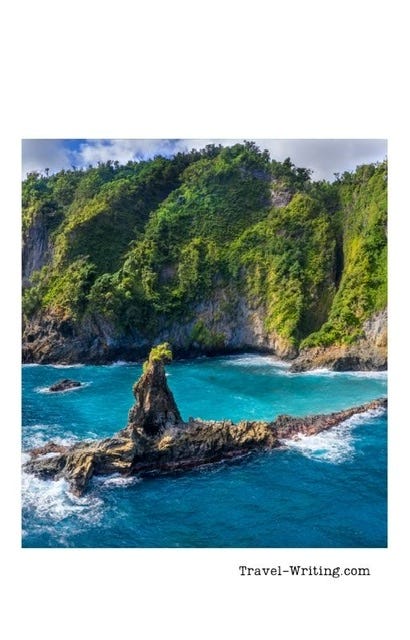
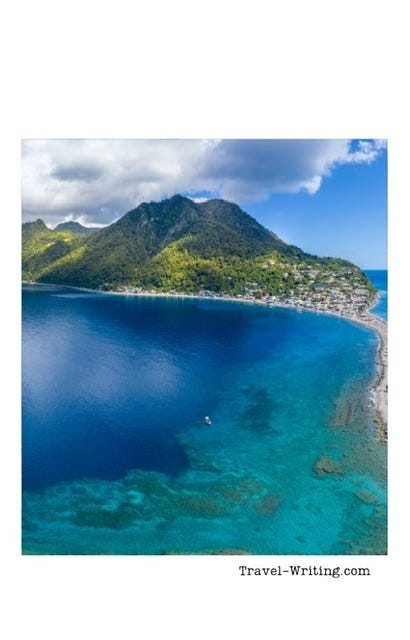
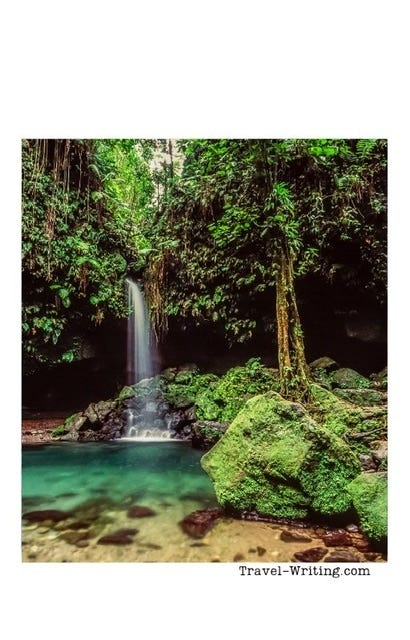
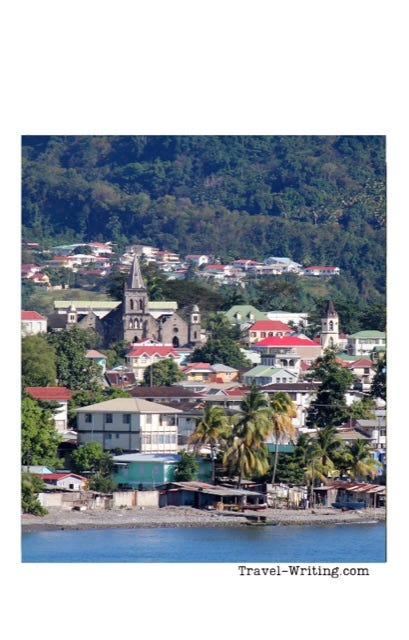
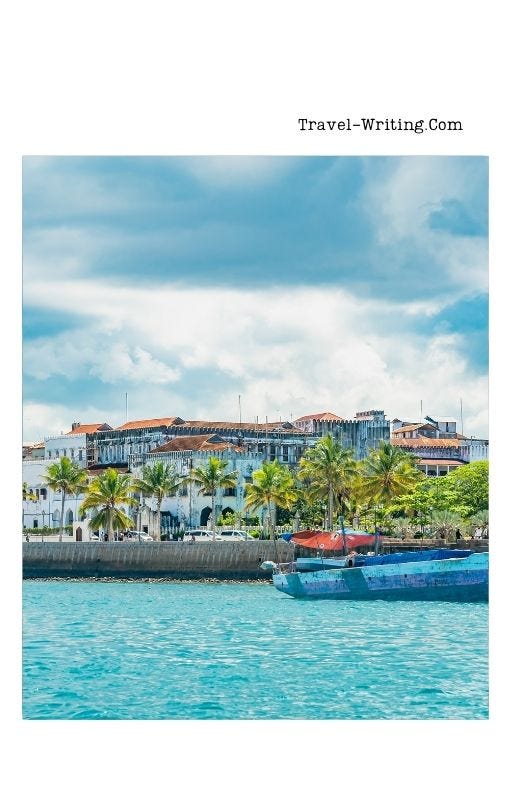
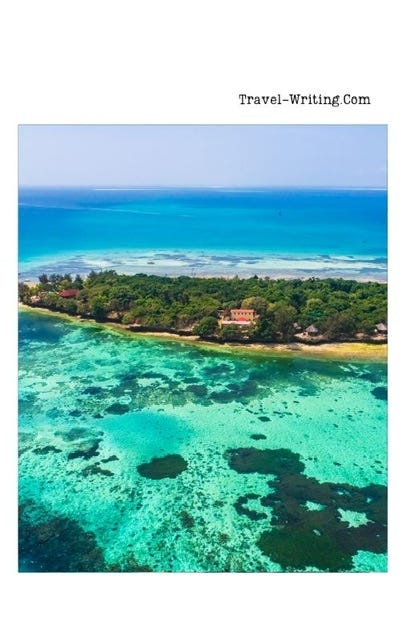
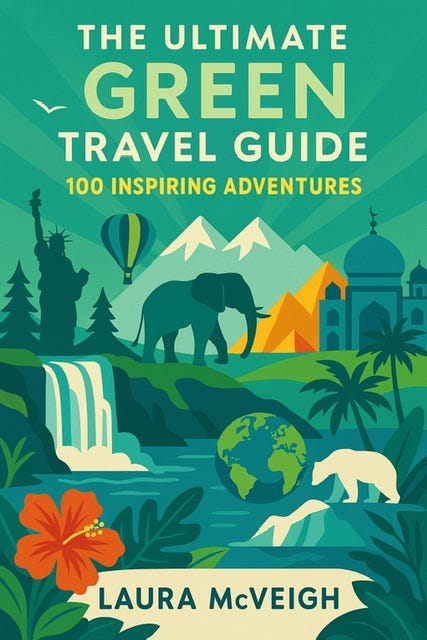
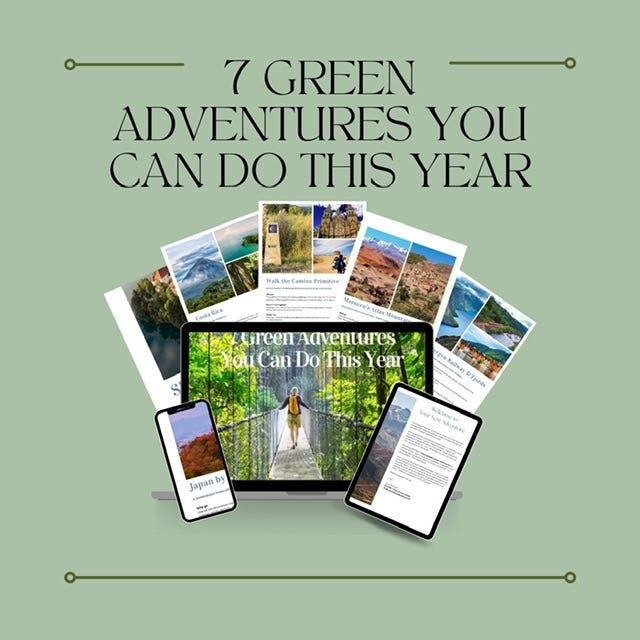
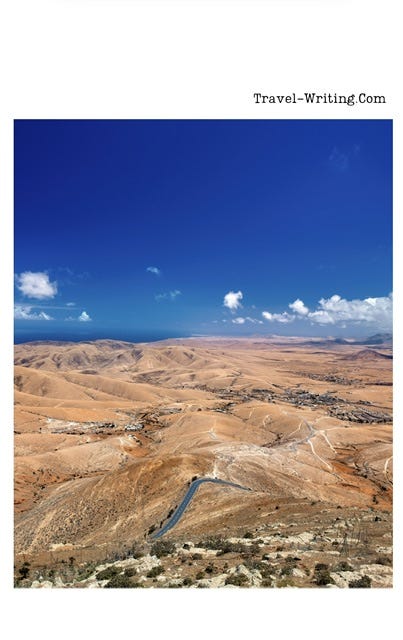
Really appreciate the way that you make clear that while there are many positive things visitors can do to help support these environments, not even "green" travel can avoid the harsh realities of nature or the impact caused by tourist activities. This is the kind of realistic but positive approach we're going to have to bring to travel in general-- making things better if well short of perfect and minimizing the damage we do often unwittingly. Resilience is the key-- being willing to look and relook at our way of traveling and trusting that nature also has a resilience that will match our human one if we allow it to.
I was so pleased to see Dominica here. While we were only there for 1 day, back in 2016, it was the place of one of my favourite travel stories.
One of the things I wanted to do while visiting was to go to the National Museum. I wasn't sure of the opening hours, and when we arrived we discovered it was closed. Never one to be deterred by a lock door, I started asking around to see if anyone knew when it would be open. Finally I spoke to someone at the tourist information office. I said that I really was hoping to visit the museum, did she know when it would be open.
She said -- just a moment, and she walked away. After a bit, she came back and told us to wait. Someone was coming with the key to let us in.
My husband and I just looked at each other. They are coming to let us in?
Yes.
The Dominica National Museum is housed in the upstairs of a harbour front building in Roseau. The woman took us up the stairs and unlocked the door. She came in to turn on the lights, and then she said -- just make sure the door closes securely behind you when you leave.
I couldn't believe it!
It is a small museum, for a small island. But it was also filled with some pretty significant treasure. Everything from natural artifacts to the silver mace that symbolized colonial rule. To be allowed to just wander at will without supervision felt like a remarkable gift to us. And it was a unique traveller's experience.
Now maybe every visitor who came to Dominica during that period who asked to see the Museum was given the same opportunity, but I have to wonder how many actually asked, or were even interested.
We absolutely loved it. And will never forget our visit to this amazing island; one to which I long to return.